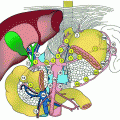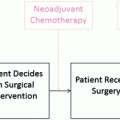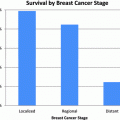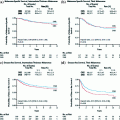The American Thyroid Association (ATA) defines central compartment neck dissection (CCND) as “the comprehensive, compartment-oriented removal of the prelaryngeal, pretracheal and at least one paratracheal lymph node basin” [2]. There is consensus that patients with clinically apparent (N1a) central compartment lymph nodes should undergo total thyroidectomy with therapeutic CCND [2]. However, in view of the prevailing contradictions on the effect of lymph node status on recurrence and survival, there is no consensus on the role of routine pCCND in patients with PTC and no clinical evidence of lymph node metastases (clinically N0), either by physical examination, preoperative ultrasonography, or intraoperative inspection at the time of thyroidectomy. As level C evidence, the current ATA guidelines on the management of patients with DTC recommends that patients with advanced primary tumors (T3 or T4) with clinically negative lymph nodes may undergo pCCND while patients with small tumors (T1 or T2) with no clinically apparent lymph nodes may be spared CCND [2]. This section will highlight some of the pros and cons of pCCND with regards to locoregional recurrence, survival, and postoperative complications based on studies from various single institution, multi-institution and large administrative databases. The reasons for the persistent controversies and how they could be effectively resolved will also be discussed.
Generally accepted prognostic factors for PTC include age, tumor size, completeness of resection, extrathyroidal extension, and the presence of distant metastases (Table 1) [11–14]. The effect of locoregional lymph node metastases on rates of recurrence and survival in patients with PTC remains controversial.
Name of prognostic grouping | Components |
|---|---|
AMES | Age, Metastases, Extent of disease, Size of tumor |
AGES | Age, Grade, Extent of disease, Size of tumor |
MACIS | Metastases, Age, Completeness of resection, Invasion, Size of tumor |
TNM | Tumor, Node, Metastasis, Age |
2.1 Recurrence
Single and multi-institution studies estimate the locoregional recurrence rate of patients with PTC to be 6–59 % [15–18]. The central compartment is the most common site of recurrence [16]. There is increased cost and morbidity in patients with recurrent disease, given that reoperative cervical surgery is associated with higher rates of recurrent laryngeal nerve injury and hypoparathyroidism, both transient and permanent [19–21]. The probability of recurrence is influenced by the lymph node status of the patient, with clinically node-positive patients having a higher rate of recurrence [22]. Studies on the role of pCCND in decreasing tumor recurrence have yielded contradictory results [9, 23–25].
The sensitivity of high-resolution ultrasonography in detecting cervical lymph node metastases is reported to be 52 % with a false negative rate of 58 % [26]. While ultrasonography has a higher detection rate than physical exam alone in the detection of metastatic lymphadenopathy, the overall detection rate remains low. Given the difficulty in predicting the presence of metastatic lymphadenopathy preoperatively, one would expect that reliance on only therapeutic CCND at the time of thyroidectomy would miss a significant number of patients with micrometastatic lymphadenopathy [27]. As a result, failure to remove microscopic metastases at the time of initial thyroidectomy would theoretically place patients at a higher risk for recurrent DTC and need for further treatment, including reoperative surgery [22, 28].
Early locoregional recurrence of DTC may be due to existing nodal metastases which was not recognized pre- or intraoperatively and thus not removed at the index operation, if routine pCCND was not performed [28]. In addition, routine pCCND and resection of micrometastatic nodal disease may influence the need for, and dosage of I-131 given at the time of subsequent RAI, although data are conflicting [27, 29, 30]. Some studies have found that patients in whom the true nodal status is unknown because they did not undergo pCCND may be under-treated and subsequently are more likely to have a locoregional recurrence; this is in part due to the fact that identification of micrometastasis ‘upstages’ PTC from Nx to N1a disease, in the American Joint Committee on Cancer (AJCC) staging system and N1a PTC is considered “Stage III” PTC in patients >45 years [27, 29, 31, 32]. Other studies, however, suggest that performance of pCCND and identification of micrometastasis may preclude the need for RAI in patients with undetectable serum thyroglobulin levels and no evidence of disease on whole body prescans performed at the time of RAI [30].
Serum thyroglobulin is a postoperative marker for recurrent PTC and higher rates of athyroglobulinemia have been reported among patients who underwent total thyroidectomy with ipsilateral pCCND [33]. A meta-analysis of 11 published studies with a total of 2,318 patients revealed a lower trend toward recurrence in patients treated with total thyroidectomy and prophylactic central neck dissection, although statistical significance was not reached, OR 0.59 (95 % CI 0.33–1.07) in favor of total thyroidectomy with pCCND [34]. The pooled recurrence rate for total thyroidectomy with pCCND was 4.7 % compared to 7.9 % in the total thyroidectomy group [34].
Contrary to the studies reporting favorably on the effect of pCCND on recurrence, some studies have not found more aggressive surgery to correlate with decreased recurrence [16, 35]. A single institution, retrospective cohort review of patients with PTC over a 60 year period found the recurrence rate among clinically node negative patients to be 0.8 % compared to a recurrence rate of 16 % in patients who had clinically positive lymph nodes at presentation [16]. There was no increased risk of mortality from thyroid cancer in the cohort that experienced tumor recurrence. Another single institution study in which all surgeries were performed by a single surgeon, did not find any central neck recurrence in patients who received total thyroidectomy with CCND, however, lateral neck recurrences were observed in 5 patients who had more than 5 metastatic central neck lymph nodes on therapeutic CCND only [36]. These findings would suggest that pCCND offers no benefit to patients with clinical N0 disease [36].
Contrary to other studies, another single institution retrospective cohort study in which both groups received post-operative 131-I therapy found similar levels of serum thyroglobulin levels at 1-year follow-up in both patients who underwent total thyroidectomy alone versus total thyroidectomy with pCCND [27].
2.2 Survival
Both single-institution, retrospective cohort studies and those using larger administrative databases, such as Surveillance, Epidemiology, and End Results (SEER) have reported no effect of metastatic cervical lymph nodes on survival [26, 37, 38]. In one study using the SEER database, multivariable analysis of the factors predictive of survival in patients with PTC did not find the effect of cervical lymph node metastasis to be statistically significant [38].
In contrast, a separate study also utilizing the SEER database reported a relative risk of 1.3 (1.20–1.5) in patients with positive cervical lymph node metastasis when multivariable analysis was performed for prognostic factors of survival [39]. The role of pCCND on survival is hard to evaluate given the relatively long-term survival in patients with PTC. A prospective cohort study of patients with PTC who received total thyroidectomy with microdissection in the city of Göteborg showed that over a median follow-up of 13 years, 1.6 % died from thyroid cancer compared to 8.4 and 11.1 % with median follow-up of 10 and 11.4 years from Bergen and Helsinki respectively where patients underwent “node picking” or no information on lymph node dissection was provided [40]. In a thorough systematic review evaluating the effect of CCND on survival [23], studies from various institutions across the world reported conflicting results. A retrospective cohort study from Hannover, Germany in which 342 patients with PTC were analyzed, found improved survival in the cohort who received systematic compartment oriented dissection compared to the cohort who received selective node removal [24]. On the contrary, another single institution retrospective cohort review of 139 patients with DTC did not find lymphadenectomy to improve survival [41]. No higher level evidence exists to conclusively settle on the effect of pCCND on survival among patients with DTC [23].
2.3 Morbidity
The potential complications of CCND include hypoparathyroidism (transient or permanent), recurrent laryngeal nerve injury (transient or permanent), esophageal injury, tracheal injury, seroma, hematoma and wound infection [42]. Transient hypoparathyroidism is the most common complication of both thyroidectomy and CCND, whether performed as a therapeutic or prophylactic procedure [9, 43].
In a meta-analysis of 5 studies with a total of 1,132 patients with DTC, transient hypoparathyroidism was an increased adverse event in patients undergoing thyroidectomy and CCND compared to thyroidectomy alone [42]. The reported incidence of transient hypocalcemia for thyroidectomy with or without CCND ranges from 1.6 to 53.6 % [20]. The rates of permanent hypoparathyroidism (1.2 %), transient vocal cord palsy (3.4 %), permanent vocal cord paralysis (1.1 %) and hemorrhage (1–2 %) were similar between those who underwent total thyroidectomy alone compared to recipients of total thyroidectomy with CCND, Table 2 [42]. Furthermore, different single institution studies report increased risk of hypoparathyroidism and recurrent laryngeal nerve injury in reoperative CCNDs, suggesting that prevention of reoperative surgery, perhaps by performing prophylactic CCND at the time of initial surgery, may be appropriate [23, 28, 44].
Table 2
Complications and incidence rates for total thyroidectomy with or without central compartment neck dissection [42]
Complication | Incidence (%) |
|---|---|
Permanent hypoparathyroidism | 1.2 |
Transient vocal cord palsy | 1.1 |
Permanent vocal cord paralysis | 3.4 |
Hemorrhage | 1–2 |
Still other studies, both single institution retrospective and prospective cohort studies, have found the complication rates of initial pCCND to be comparable to reoperative CCND [9, 45], thus suggesting that if patients experience a recurrence, they can be operated on safely and therefore they should not undergo CCND at first operation if cervical nodes are clinically negative. A large single institution retrospective review of 295 patients at a high-volume center in which 189 patients had initial total thyroidectomy with pCCND and 106 patients underwent reoperative surgery reported the following rates of complications when comparing the two cohorts: permanent hypoparathyroidism (0.5 % vs. 0.9 %), neck hematoma (1.1 % vs. 0.9 %), permanent hoarseness (2.6 % vs. 1.9 %) [9]. Furthermore, in contrast to the previously discussed meta-analysis by Chisholm et al. [42] in which patients undergoing total thyroidectomy and pCCND had only transient hypoparathyroidism as a worse outcome compared to total thyroidectomy alone, others have reported increased rates of permanent hypoparathyroidism [23, 46]. A systematic review of multiple single institution cohort studies by White et al. concluded that the rate of permanent hypoparathyroidism may be higher in patients who undergo CCND [23]. The sub-samples analyzed in the cohort studies to derive the incidence of permanent hypoparathyroidism were small and the reported rates of permanent hypoparathyroidism ranged from 1.4 to 4 % among the cohort who underwent total thyroidectomy with CCND [23]. These data would suggest that pCCND may place patients at higher risk of postoperative morbidity.
The majority of previous studies investigating the issue of pCCND in patients with PTC have been case reports, case series, prospective, or retrospective review of single or national databases, although some meta-analyses have recently been performed. Another weakness of the single institution studies is that, they are usually done at high-volume centers where surgeries are done by very experienced surgeons; hence the findings may not be generalizable. Furthermore, much of the existing literature comparing postoperative morbidity in patients undergoing total thyroidectomy with or without CCND do not accurately distinguish between prophylactic and therapeutic CCND and the extent of lymphadenectomy performed is difficult to assess in a retrospective manner. None of the studies on this controversial issue has a level of evidence better than III, Grade C. Despite the benefit of large sample size in studies using Surveillance, Epidemiology and End Results (SEER) data, the lack of a robust randomized controlled clinical trial to effectively compare thyroidectomy alone versus thyroidectomy with pCCND has left this controversy unresolved. A randomized, controlled study examining postoperative calcium supplementation in patients following total thyroidectomy did not identify patients undergoing CCND, prophylactic or therapeutic, to be at higher risk of postoperative hypoparathyroidism, although this study was not designed to look specifically at the issue of CCND [47].
2.4 Challenges to Obtaining a Higher Level of Evidence
There are several challenges to conducting a randomized controlled trial to address the role of pCCND in patients with PTC. The low incidence of PTC, the overall low morbidity associated with pCCND and the favorably long survival necessitates a very large sample size and long follow-up time in order to detect statistically significant differences in outcome [45]. The feasibility of a multicenter randomized controlled trial is also constrained by the high budgetary estimate of $20 million [45]. Existing studies are limited by multiple factors. First, there is heterogeneity of the histology of study participants. In some studies, there are no separate subgroup analyses between PTC and follicular thyroid cancer; follicular thyroid cancer does not typically spread via the lymphatic channels and therefore, pCCND has little clinical utility in this subset of patients. Second, earlier studies may not meet the current ATA definition of a pCCND, making the extent of lymphadenectomy difficult to determine. Next, most existing studies did not have a control group of patients who did not undergo CCND and there is wide variability in inclusion/exclusion criteria and confounding factors, thus making it difficult to examine the direct effect of pCCND. Finally, temporal trends in knowledge, imaging, diagnosis, surgical technique and patient preferences call for a more robust, contemporary study.
2.5 How High Quality Evidence May Be Obtained
Large healthcare systems with integrated electronic health records such as American College of Surgeons National Surgical Quality Improvement Program (ACS NSQIP) regional collaboratives may be able to implement a prospective cohort study to compare patients with cN0 who receive total thyroidectomy with age-matched patients with cN0 who undergo total thyroidectomy with pCCND. In such a study, standardized definitions of variables would be used thus decreasing the variability that has characterized most existing studies. Given the favorable long-term survival in patients with PTC, these cohort studies would examine short to medium term outcomes such as complications and recurrence. Also, the findings are likely to be more generalizable since the spectrum of hospital volume and surgeon experience will reflect the real world as opposed to a single institution. While this type of prospective cohort study may not be as robust as RCT, it may not be hampered by the same barriers that make RCT infeasible [45].
3 Postoperative Radioactive Iodine Therapy for Papillary Thyroid Cancer
RAI using 131-I is an important adjunct in the treatment of patients with PTC. Given the high avidity of thyroid tissue for iodine, administered 131-I enters remnant thyroid tissue where it kills tissues. Controversy exists regarding: (1) whom should undergo additional postoperative treatment with RAI; (2) THW versus recombinant TSH (rhTSH) stimulation prior to remnant ablation; and (3) the optimal dose of 131-I.
3.1 Indications for Administration of RAI in Patients with PTC
RAI is used for remnant thyroid tissue ablation resulting in the [2, 48] (i) destruction of microscopic remnants of thyroid tissue with the goal to decreasing tumor recurrence (ii) facilitation of follow-up and early detection of persistent or recurrent disease based on serum thyroglobulin levels (iii) facilitation in identifying previously undiagnosed or persistent disease when the post-ablation therapy scan is performed. 131I may also be used for adjuvant therapy after complete surgical resection [2].
There remains debate about the use of postoperative RAI in patients with PTC, particularly in patients at low-risk for disease recurrence. Factors predictive of low-risk versus high-risk for disease recurrence and mortality are shown in Table 3 [49].
Table 3
Factors predictive of high versus low risk of recurrence and mortality (adopted and modified from Mazzaferri and Kloos) [49]
High risk features | Low risk features |
|---|---|
Age <15 years or >45 years | Age 15–45 years |
Male sex | Female sex |
Family history of thyroid cancer | |
Size >4 cm in diameter | Size <4 cm |
Bilateral disease | Unilateral disease |
Vascular invasion | No vascular invasion |
Extrathyroidal extension | No extrathyroidal extension |
Cervical/mediastinal lymph node metastasis | No lymph node metastasis |
High histologic grade | Low histologic grade |
Poor concentration of radioiodine in tumors or metastasis | Tumors with high radioiodine avidity |
Distant metastasis | No metastasis |
The ATA has made recommendations for use of RAI ablation based on the AJCC TNM staging criteria for PTC, Table 4 [2]. With the exception of patients with metastatic disease, no level A evidence exists to guide the recommendations, hence the persistent variation in the use of RAI therapy, although studies have shown an increasing trend in RAI usage [50]. A recent retrospective review of the SEER database found that for every 3 years, there is an average increase in RAI use by 1.5 % [50].
Table 4




Factors, recommendations and level of evidence regarding radioiodine remnant ablation (adopted and modified from ATA guidelines) [2]
Stay updated, free articles. Join our Telegram channel

Full access? Get Clinical Tree







